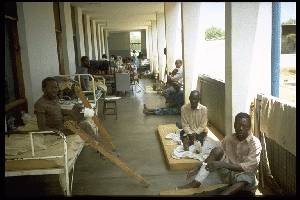|
|
|

|
Malawi Health Care Support UK
|
| Typhoid Fever | |

Hospital in Malawi |
Typhoid Fever is caused by the Salmonella typhi bacterium.
It usually enters the body through the mouth, carried in infected food or drink.
Once inside it penetrates the intestinal wall, and enters the lymphoid tissue. The bacterium multiply in this tissue and then enter the bloodstream. (This usually occurs 1-5 days after initial entry in to the body.) About 2 weeks later there are extremely large numbers of bacilli. At this time symptoms start to show. The lymph follicles in which the bacteria multiplied may dislodge. |
The main treatments for typhoid are based on antibiotics. Drugs such as Chloramphenicol and Ampicillin reduced the fever in a matter of days. Continued use of the drugs, (for several weeks), usually sees the patient make a full recovery. About 5% of cases will go on to become long term carriers of the bacteria. This does mean the risk is always present of an outbreak. This is especially true in countries such as Malawi with relatively poor hygiene standards and problems such as flooding.